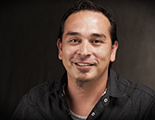
Miguel Maestas
Las Vegas, NM — Two New Mexico Highlands University computer science students received top awards from the Santa Fe Institute for their cutting-edge three-dimensional robotic vision system research.
Graduate student Miguel Maestas won first place for graduate research and senior Jared Leyba won first place for undergraduate research at the Santa Fe Institute’s Student Computational Thinking Symposium Dec. 7.
Maestas and Leyba, who were each awarded $200, competed with students from universities throughout the state, including the University of New Mexico, New Mexico State University, Northern New Mexico College, and more.
The Highlands students presented both poster and oral presentations of their research at the symposium. Bob Robey, a computational physicist and senior research scientist at Los Alamos National Laboratory, was on the industry judging panel.
“Robotics is a hot field now and using visioning information to guide direction is very challenging,” Robey said. “The amount of programming and intelligence Miguel built into his system is quite impressive. He is achieving at the level of students at leading research institutions across the country. Jared’s research was remarkable for an undergraduate student.
“Both these Highlands students produced excellent applied computer science research projects with real-world applications that could make significant impacts in our current world with automated vehicles, mapping spaces, and moving through the environment,” Robey said.
Maestas, a Las Vegas native, developed a 3-D vision system and interactive 3-D motion control system for guiding a two-foot unmanned robotic quadcopter using a robotic operating system, or ROS. His systems are intended for mapping and navigation in previously unmapped environments.
“I programmed the Parrot AR.Drone quadcopter to communicate wirelessly with a laptop or PC,” Maestas said. “The word drone can have negative connotations. Our research focus is on non-military applications in a variety of areas such as search and rescue, wildlife tracking, or surveying wildland fire burn sites where traditional methods may pose a danger to humans.
“Being judged by scientists in the computational industry was gratifying. The interest they showed in my robotics research validates my own research interest and aspirations. I plan to eventually apply to a doctoral program in mechanical engineering with a specialization in robotics,” Maestas said.
Leyba of Santa Fe is developing an embedded 3-D stereoscopic vision system for constructing synthetic holograms that allows the user to see what the robot is seeing. He also employed a robotic operating system in his research.
Computer science professor Gil Gallegos supervised Maestas and Leyba’s research. Gallegos also presented on a computational education panel at the Santa Fe Institute symposium, along with Highlands media arts professor Megan Jacobs.
“Miguel’s research is unique because he’s integrating the ROS framework with 3-D vision. Jared’s research is unique because he’s using the ROS framework for synthetic holography. Both are new areas of research.
“Miguel and Jared are highly intelligent self starters who are passionate about what they do in computer science. Their work is excellent and they’re good colleagues,” Gallegos said.
Maestas, 36, is also the career technical adviser at Highlands for Accelerate New Mexico, a technical training and job placement program. He completed his B.S. in computational engineering at Highlands in 2009. Gallegos was his adviser then and now.
“Dr. Gallegos fosters independent thinking and creative, useful solutions to computational challenges. He pushes us to excel,” Maestas said.
Robey said that Gallegos is a dedicated professor who is well versed in the latest computational developments.
“Gil communicates his knowledge and passion for computer science to his students and motivates them to get involved in cutting-edge research. He makes research both challenging and exciting. That’s what we need in our universities to advance science,” Robey said.
Maestas and Leyba are part of an ongoing computer science and engineering project seven of Gallegos’ students are conducting in synthetic holography — what he calls true 3-D reconstruction of a 3-D environment.
The research is funded through the university’s National Science Foundation Partnerships for Research and Education in Materials (PREM) grant that chemistry professor Tatiana Timofeeva secured in 2009.
